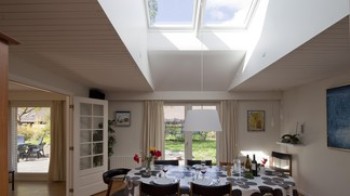May 4 2013
Through a collaborative project supported by VELUX between Prof. Marilyne Andersen at EPFL, Head of the LIPID laboratory, and Prof. John Mardaljevic at Loughborough University (UK), specialized in Building Daylight Modeling, new analysis perspectives regarding the potential health benefits of increasing daylight access through skylights have been explored.
 © 2013 EPFL
© 2013 EPFL
In these early investigations, selected findings from the circadian photoreception research field were incorporated into a new framework for building simulation.
Studying the non-visual impacts of skylights in residential settings
Through a collaborative project supported by VELUX between Prof. Marilyne Andersen at EPFL, Head of the LIPID laboratory, and Prof. John Mardaljevic at Loughborough University (UK), specialized in Building Daylight Modeling, new analysis perspectives regarding the potential health benefits of increasing daylight access through skylights have been opened. In these early investigations, selected findings from the circadian photoreception research field were incorporated into a new framework for building simulation.
In addition to its well-known visual effects, lighting is also responsible for a number of so-called non-visual (or non-image forming) effects which, amongst others, influence our body clock, sleep quality, alertness, and immune system. The simulation framework established for this project was used to conduct a sensitivity analysis regarding the extent to which climate conditions may influence light exposure at the eye in a residential setting – and thus ultimately the likelihood of inducing non-visual effects. The study was made for eight European countries: France, Germany, Sweden, Poland, Italy, the UK, Russia and Spain, and showed that, in spite of the variety of climate conditions, the addition of roof windows significantly increased ocular light exposure over the year indoors and with an obviously appropriate light-dark cycle given that it is driven by the natural day-night cycle. A video has been created by the VELUX Corporation to present the outcomes of this study, as well as a press release. The study report and associated paper further discuss the preliminary model assumptions that were made and the visualization formats that were developed to make this kind of information meaningful in a design process. New developments efforts regarding the incorporation of dynamic non-visual effects in lighting simulation are underway at LIPID.